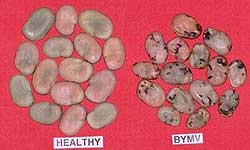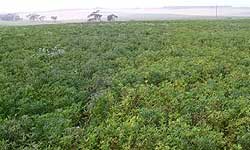Temperate pulse viruses: bean yellow mosaic virus
 Bean yellow mosaic virus (BYMV) was first reported on French beans from the USA and the Netherlands in 1925, and is now distributed worldwide.
Bean yellow mosaic virus (BYMV) was first reported on French beans from the USA and the Netherlands in 1925, and is now distributed worldwide.
It has a wide host range which includes the temperate pulses and pasture legumes, tropical legumes and ornamental hosts.
The virus is spread by a number of aphid species non-persistently as well as being seed and mechanically transmitted.
What to look for
Symptoms of BYMV in the major temperate pulses and pasture legumes are:
- faba beans develop vein yellowing, followed by obvious green or yellow mosaic vein banding with yellowish line patterns (Figure 1). Symptoms are more prominent on young leaves. Seed symptoms include irregular brownish to blackish staining (Figure 2).
- Symptoms on field peas are variable. The virus may be symptomless or may induce bright mosaic, mottling of leaves and clearance of veins. Necrosis may occur on tips, in stems and veins (Figure 3).
- Desi chickpeas develop apical necrosis, reddening, plant stunting and premature senescence.
- Kabuli chickpeas develop apical necrosis, yellowing, plant stunting and premature senescence.
Lentils develop mild mosaic, light green or yellow leaves. A reduction in leaf size and stunting may occur. Infected plants produce very little seed. - Narrow-leaf lupins, infected with the necrotic strain of BYMV, initially develop yellow leaves followed by necrosis of growth tips and plant death (Figure 4). Non-necrotic strains of BYMV cause yellowing and dwarfing, but do not cause death of the plant.
- Subterranean clover plants develop leaf mottling, leaf deformation and distinct yellowing between the veins. Plants become dwarfed and symptoms usually occur in patches, and along the edges of paddocks.
Disease cycle
 Transmission
Transmission
BYMV is transmitted by more than 50 aphid species in a non-persistent manner.
The main species worldwide are:
- pea aphid (Acyrthosiphon pisum)
- black bean aphid (Aphis fabae) (not found in Australia)
- cotton aphid (Aphis gossypii)
- foxglove aphid (Aulacorthum solani)
- cabbage aphid (Brevicoryne brassicae)
- green peach aphid (Myzus persicae)
- corn aphid (Rhopalosiphum maidis).
 During surveys in Victoria the following BYMV vectors in pulse crops were detected:
During surveys in Victoria the following BYMV vectors in pulse crops were detected:
- blue green aphid (Acyrthosiphon kondoi)
- cowpea aphid (Aphis craccivora)
- foxglove aphid (Aulacorthum solani)
- cabbage aphid (Brevicoryne brassicae)
- green peach aphid (Myzus persicae).
In Western Australia, the following MYMV vectors have been reported (Berlandier et al., 1997):
- blue green aphid (Acyrthosiphon kondoi)
- cowpea aphid (Aphis craccivora)
- green peach aphid (Myzus persicae)
- dock aphid (Brachycaudus rumexicolens)
- turnip aphid (Lipaphis pseudobrassicae)
- corn aphid (Rhopalosiphum maidis)
- oat aphid (Rhopalosiphum padi)
- grain aphid (Sitobion miscanthi)
- spotted alfalfa aphid (Therioaphis trifolii forma maculata).
The virus is also transmitted through seed of most temperate pulses including:
- faba beans
- field peas
- lentils
- lupins
- through seed of a number of forage legumes and clovers.
In Victoria, the department found 18% of lentil seed lots tested had BYMV infections of 0.1-0.9%.
In Western Australia, the following BYMV seed transmission was reported (McKirdy et al., 2000):
- yellow and white lupins 3-6%
- field peas 0.3-0.8%
- faba beans 0.4%
- lathyrus 0.1-0.2%
- vetch 0.5%.
Seed transmission of BYMV in medics, clovers and weeds has also been reported in Western Australia (McKirdy and Jones 1995):
- hexham scent (Melilotus indica) (0.5%)
- burr medic (Medicago polymorpha) (0.9%)
- barrel medic (Medicago truncatula) (0.3%)
- hare's foot clover (Trifolium arvense) (0.1%)
- hop clover (Trifolium campestre) (0.2%)
- cluster clover (Trifolium glomeratum) (0.05%).
Host range
The host range of BYMV is wide and not limited to Fabaceae. The virus is reported to infect nearly 200 species in 14 families.
Temperate pulse hosts include:
- chickpeas
- faba beans
- field peas
- lentils
- lupins.
Temperate legume pasture hosts include:
- lathyrus
- lucerne
- vetch
- medic and clover species.
BYMV has a number of subtropical and tropical pulse hosts including:
- soybeans
- peanuts
- French beans
- legume pasture hosts.
It also infects ornamental hosts, the most common being gladiolus species.
Economic importance
In New South Wales a small survey showed that faba bean crops had an average within-crop incidence of BYMV of 26% of plants (ranging from 1-63%) (van Leur et al. 2002).
Field surveys in Western Australia in 1998-1999 showed that some faba bean and field pea crops were infected with BYMV and the within crop virus incidences were 31% and 18% respectively (Latham and Jones 2001).
Plot trials in Western Australia showed that lupins infected with the necrotic strain of BYMV can have grain yields reduced by 95% (Cheng and Jones 1999). Seed yield losses recorded on subterranean clover due to infection with BYMV were 58-76% (Jones 1992).
Pulse crop surveys in the last 10 years indicate that BYMV is a minor problem, but in some years the virus levels may be high in lupins, field peas and faba beans in south eastern Australia.
Percentage of pulse crops infected with bean yellow mosaic virus in south eastern Australia and within crop virus incidence
Victoria — Lentil
Year | % of sampled crops infected | Within crop virus incidence range % |
|---|---|---|
2000 | 2 | 1 |
2001 | Virus not found | Virus not found |
2004 | Virus not found | Virus not found |
2006 | Crop not sampled | Crop not sampled |
2007 | Virus not found | Virus not found |
Victoria — Faba bean
Year | % of sampled crops infected | Within crop virus incidence range % |
|---|---|---|
2000 | 6 | 15 |
2001 | Virus not found | Virus not found |
2004 | 9 | 2 |
2006 | Crop not sampled | Crop not sampled |
2007 | 20 | 1 to 7 |
Victoria — Field pea
Year | % of sampled crops infected | Within crop virus incidence range % |
|---|---|---|
2000 | Virus not found | Virus not found |
2001 | Virus not found | Virus not found |
2004 | Virus not found | Virus not found |
2006 | 10 | 3 |
2007 | 31 | 1 to 24 |
Victoria — Lupin
Year | % of sampled crops infected | Within crop virus incidence range % |
|---|---|---|
2000 | Virus not found | Virus not found |
2001 | Virus not found | Virus not found |
2004 | Crop not sampled | Crop not sampled |
2006 | Crop not sampled | Crop not sampled |
2007 | 75 | 5 to 11 |
South Australia — Lentil
Year | % of sampled crops infected | Within crop virus incidence range % |
|---|---|---|
2001 | Virus not found | Virus not found |
2003 | Virus not found | Virus not found |
2004 | Virus not found | Virus not found |
2005 | Virus not found | Virus not found |
2006 | Virus not found | Virus not found |
2007 | 33 | 1 to 4 |
South Australia — Faba bean
Year | % of sampled crops infected | Within crop virus incidence range % |
|---|---|---|
2001 | Crop not sampled | Crop not sampled |
2003 | Virus not found | Virus not found |
2004 | Virus not found | Virus not found |
2005 | Virus not found | Virus not found |
2006 | Virus not found | Virus not found |
2007 | 5 | 1 |
South Australia — Field pea
Year | % of sampled crops infected | Within crop virus incidence range % |
|---|---|---|
2001 | Crop not sampled | Crop not sampled |
2003 | Virus not found | Virus not found |
2004 | Virus not found | Virus not found |
2005 | Virus not found | Virus not found |
2006 | Virus not found | Virus not found |
2007 | 18 | 2 |
South Australia — Lupin
Year | % of sampled crops infected | Within crop virus incidence range % |
|---|---|---|
2001 | Crop not sampled | Crop not sampled |
2003 | Crop not sampled | Crop not sampled |
2004 | Crop not sampled | Crop not sampled |
2005 | Crop not sampled | Crop not sampled |
2006 | Virus not found | Virus not found |
2007 | Virus not found | Virus not found |
New South Wales — 2006 Southern
| Crop | % of sampled crops infected | Within crop virus incidence range % |
|---|---|---|
| Lentil | Crop not sampled | Crop not sampled |
| Faba bean | Virus not found | Virus not found |
| Field pea | 8 | 1 |
| Lupin | Crop not sampled | Crop not sampled |
In 2009, chickpea surveys were conducted in Victoria, South Australia, Southern and Northern NSW. BYMV was not found in any chickpea crop sampled.
Management
Seed is considered to be one of the main sources of BYMV, therefore sowing virus tested seed is recommended and commercial seed tests are available.
BYMV causes heavy losses in narrow leafed lupins, so only virus tested seed is recommended for sowing. Virus resistant lupin varieties are now available in Western Australia.
BYMV infected pastures are another major source of the virus, which is then spread to crops by aphids. Chemical control of aphids is not an effective method for controlling non-persistently transmitted viruses such as BYMV.
Pulse crops should be sown away from legume pastures to minimise the spread of BYMV. The spread of virus can also be reduced by controlling weed hosts in and around paddocks.
Further references
- Victorian crop sowing guide
- Seed health testing in pulse crops
- Pulse Australia
- Winter Pulse Disorders: The Ute Guide.
- Pulse Australia - Virus control in chickpea–special considerations
- Pulse Australia Tech-Notes Autumn 2010 - Chickpea 'sudden death' in 2009
- Jones RAC (1992). Australian Journal of Agricultural Research 43, 1229-1241.
- McKirdy SJ, Jones RAC (1995) Australian Journal of Agricultural Research 46, 135-152.
- Berlandier FA, Thackray DJ, Jones RAC, Latham LJ and Cartwright L (1997) Annals of Applied Biology 131, 297-314.
- Cheng Y and Jones RAC (1999) Australian Journal of Agricultural Research 50, 589-99.
- McKirdy SJ, Jones RAC, Latham LJ and Coutts BA (2000) Australian Journal of Agricultural Research 51, 325-45.Latham LJ, Jones RAC (2001). Australian Journal of Agricultural Research 52, 397-413.
- McKirdy et al. (2000). Australian Journal of Agricultural Research 51, 325-345.
- Van Leur J, Makkouk K, Freeman A, Schilg M (2002) Proceedings of the 8th International Congress of Plant Pathology, 2-7 February, Christchurch, New Zealand, p265.
Contact
Dr Piotr Trebicki
Virologist – Horsham
03 5450 8301
Field Crops Pathology
Grains Innovation Park
110 Natimuk Rd
Horsham 3400
03 5450 8301
Or call the Customer Service Centre, 136 186
Image credits
Figure 2 photograph courtesy of Safaa Kumari ICARDA
Figure 3 photograph courtesy of Joop vaLeur, DPI NSW
Acknowledgments
Mohammad Aftab, Angela Freeman, Frank Henry. Support by the Grains Research and Development Corporation is gratefully acknowledged.